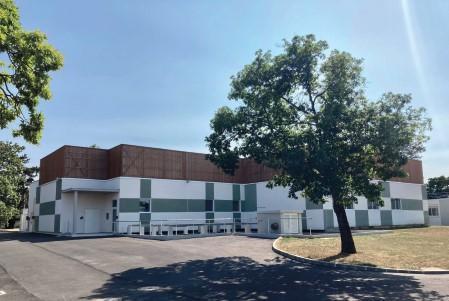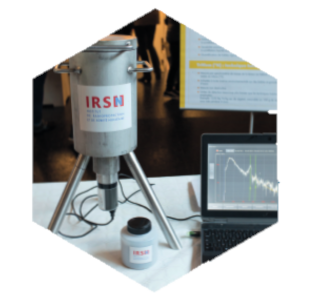LATAC Platform

LATAC is a multi-purpose environmental sample analysis platform meeting the most modern industrial standards: programmable ventilation with controlled pressure, reinforced soundproofing, centralised supervision, dedicated waste area, centralised effluents network. Its structure revolves around the sample's journey, from receipt to analysis and storage.
Context
As part of its remit, IRSN constantly monitors radioactivity in France. It takes and analyses several thousand environmental samples every year.
To better fulfil its mission of monitoring radioactivity in France, IRSN has set up a new analysis platform at its site in Le Vésinet (78), the LATAC ‘Laboratory for Processing and Analysing Environmental Samples in Post-Accident Situations’.
Designed around the successive operations to be carried out, from taking samples to analysing them, including their concentration and radiochemistry, it is equipped with more than 45 high-tech facilities for processing and analysing all types of samples.
Thanks to this new technical platform, IRSN can analyse up to 150 samples per day, depending on the measurement performance targeted, a high capacity compared with other laboratories specialising in this field.
Detailed description
The platform meets the most modern industrial standards with :
- programmable ventilation with controlled pressure
- reinforced soundproofing
- centralised supervision
- a dedicated waste area
- a centralised effluents network
600m2 of laboratories and workspaces, 19 fume hood, 1 glove box, 11 treatment equipment, 35 measuring instruments.
Sample route
LATAC's structure revolves around the sample's journey, from reception to analysis and conservation.

- Radiological control
- Verification of their integrity and recording of associated information
- Allocation of a unique identifier for traceability purposes
As the levels of radioactivity in the environment are very low, it is generally not possible to analyse the sample directly. Preliminary treatments are therefore carried out in order to concentrate the radionuclides and even to anticipate possible radiochemical analyses (filtration for water, drying, sieving, calcination for solids).
Sample analysis
As the levels of radioactivity in the environment are very low, it is generally not possible to analyse the sample directly. Preliminary treatments will be carried out in order to concentrate the radionuclides and even to anticipate any radiochemistry that may be required.
-
By alpha spectrometry
As α-rays are difficult to measure, extensive radiochemistry will be systematically carried out to isolate the radionuclide of interest, whose activity will then be measured using a semiconductor.
-
By gamma spectrometry
The detector measures the energy and intensity of the gamma rays emitted by the sample to determine the radionuclides present and their activity. This is a ‘non-destructive’ method that does not alter the sample.
-
Liquid scintillation
The detector measures the light radiation emitted by a scintillating liquid under the influence of electrons from radioactive decay. This technique may require prior radiochemistry afin order to avoid interferences during measurement.
-
By ICP-MS
This method does not rely on the radioactivity of the sample, but on the difference in mass between the atoms to measure their concentration and thus trace their activity. This high-performance method can detect minute traces of radioactivity.
-
By proportional counting
This technique makes it possible to determine the total activity of alpha or beta emitting radionuclides present in a sample, without however making it possible to identify them. It provides an indicator for screening samples, used in the monitoring of drinking water, for example.
Development of analytical capabilities
In addition to carrying out radiological analyses, IRSN develops new methods and tools to strengthen its capacities and improve its performance, including by welcoming students every year and developing its international cooperation.

-
Rapid ICP-MS measurement technique
This innovative measurement method reduces routine analysis times for the measurement of certain radionuclides (90Sr, uranium, thorium and plutonium isotopes, 237Np, 241Am and 244Cm). These radionuclides are complex to measure because they generally require lengthy and detailed radiochemistry. This technique can be used to reduce the time required from several weeks to a few hours, for example in an emergency situation.

-
Tri-LATAC: a tool to facilitate inspections
Tri-LATAC is a device designed by IRSN in collaboration with the Laboratoire National Henri Becquerel (CEA/LNHB) to enable radiological monitoring of foodstuffs following a nuclear accident. It incorporates mathematical algorithms for rapid identification of the radionuclides of interest (137Cs, 131I, etc.) and has been designed for deployment as close to the population as possible.

-
Spectral demixing
Spectral unmixing uses statistical algorithms to analyse the spectra obtained by gamma spectrometry: from a library of signatures, the programme will determine the best combination of radionuclides to explain the spectrum measured. This work, the result of several theses, now makes it possible to considerably reduce quantification time and even to detect radionuclides that were previously difficile to detect.
International cooperation
In the field of environmental monitoring and metrology, IRSN collaborates and exchanges with numerous European and international partners, including international organisations such as the IAEA, authorities and technical support organisations (BfS in Germany, KAERI in South Korea, etc.) and universities and research laboratories (Singapore, Canada, etc.).




